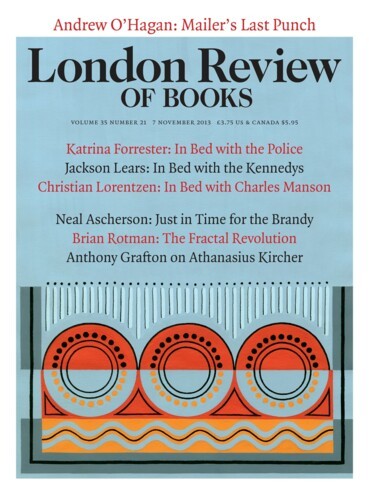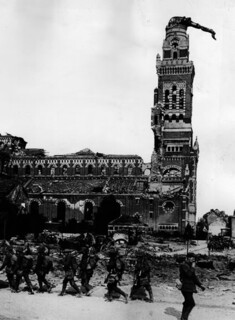Albert wrote to his sister Mabel from the trenches. That Mary he’d danced with, could she find out if Mary ever thought about him? Mabel considered he was too young for all that, it wasn’t proper. So she didn’t ask. But then he wrote again, so she did.
‘My insides go all jumbly when I think about Albert,’ said Mary to Mabel. So Mabel put that in her next letter to Albert. But the letter came back with two ink stamps on it: ‘Undelivered’ and ‘Killed in Action’. Albert was 16.
The white stones reel away across the grass in sightlines that open and close, thousand upon thousand, and you might expect to feel that after the first five or six war cemeteries you have seen them all. But each one is sharply different. Albert can be found in Berks Cemetery Extension, Ploegsteert. At Hermiès, among the blue Michaelmas daisies, lies a brigadier-general with the Victoria Cross who was only 25 years old when he died. From the Irish cemetery near Ploegsteert you can see the ornate tower of Messines church, sketched in ruin by a German divisional runner called A. Hitler. In a small Commonwealth plot on the Ypres outskirts, surrounded by houses, a hound in an echoing iron shed is barking fit to wake the dead and the graves are carpeted with large, delicious and expensive ceps.
The Flemish know their mushrooms, but nobody picks these ones. The British visitors pay no attention to ‘toadstools’; we crouch down awkwardly – we aren’t young – to read names and epitaphs. ‘I just can’t help myself; I must dead-head these roses.’
All the British survivors have gone now (the men, that is. Just possibly there are bereaved women still alive, but nobody seems to ask about them.) In a hundred years, most things fall silent or shrivel into peculiar objects in display cases. The Crimean War began in 1854; in 1954, it was to me no more than a distant pageant of men with uncommon facial hair, pillbox hats and frogged tunics. By the time British troops went back into Afghanistan after 9/11, nobody in this country felt that the Second Boer War (1899-1902) was ‘relevant’ to what was happening. But the Great War, which ought to be in every sense history, keeps on speaking to us.
It’s not easy to say why. The old Western Front region, the belt of land from Belgian Flanders south to the Somme valley and beyond, is what archaeologists call a ‘ritual landscape’, a Salisbury Plain or Kilmartin Glen planned on a giant scale and datable mainly to the early 20th century. From Stonehenge, if you know where to look, you can see distant barrow groups to the south-west, the ‘cursus’ earthwork crossing a low ridge, the processional way to the river, the site of the Woodhenge circle. From the chalk hills of the Somme, above the Ancre valley, you can make out the white squares and rectangles of the cemeteries scattered across the fields or at the edge of those deadly woods: Delville, Mametz, Gommecourt. A blazing gleam on the skyline is a warriors’ icon: the gilded Madonna on the church at Albert who was hit by German artillery in 1915 and hung head downwards for most of the war. And every so often, here and in Flanders and the open Artois prairies, rise the temples: massive stone palaces of mourning in a wild variety of styles, their walls grey with the names of the dead and the missing.
The cult is still practised, in contrast to Stonehenge. The poppy wreaths are fresh; parties of schoolchildren from Leeds or Birmingham or London jump down from their coaches every day to see the graves of Tyne Cot by Passchendaele, or the cemetery at Vis-en-Artois. Groups of English, Welsh and Scottish visitors gather each night of the year at the Menin Gate in Ypres, to hear the bugles blow the Last Post under the enormous floodlit vault inscribed with the names of 54,896 men ‘who have no known grave’.
They disperse reluctantly, wordlessly. It looks as if the British – with the old Commonwealth peoples – keep faith with the cult more steadily than others. Its priesthood, the Commonwealth War Graves Commission, maintains its countless cemeteries immaculately. The French and German cemeteries (the bones and ashes of some 45,000 German soldiers lie in one graveyard alone at Neuville-St Vaast) seem less visited, less manicured.
All cults, in the Bronze Age or today, change emphasis and practice over time. In the later monuments, the early language of ‘supreme sacrifice’ or ‘they died that we might live’ falls away. The delayed wave of war memoirs, poetry and fiction which appeared after about 1928 (Remarque, Sassoon, Edmund Blunden among many others) may have sobered the memorial designers. God also retreats several paces from the iconography, although the graves of the unidentified dead are still marked ‘Known to God’ and the families still write: ‘May God protect you: One of the Best.’
Change has also come to the huge South African shrine at Delville Wood, much of it completed in the apartheid years. There is a new flag, new tablets remembering the Africans who died in Pretoria’s service. More than three thousand white soldiers went into this wood in 1916, and a few days later just over six hundred were still alive and on their feet. The wood, smashed to black spikes, was replanted but its floor is still a crazy pattern of shell-holes.
A Jan Smuts quotation is set in bronze. ‘I do sincerely believe that we are struggling for the preservation, against terrible odds, of what is most precious in our civilisation.’ Few of the women bringing poppy crosses, or the young teachers trying to explain the Thiepval monument to their teenagers, would swallow that, or even understand it. All the same, opinion about the Great War hasn’t moved in a straight line. The view that it was not a triumph, not even a tragedy, but a crime committed by idiot politicians and numbskull upper-class generals became widespread in the 1930s but peaked in the 1960s with Joan Littlewood’s Oh! What a Lovely War. Since then, there’s been a limited counter-attack. The war, according to some voices, was worth fighting and victory over an expansionist Germany was worth the losses. The British generals were not all ‘donkeys’ and their ‘big push’ offensives were not all unsuccessful. After all, didn’t they win in the end?
Well, only just. Ludendorff’s great offensive in March 1918 might have thrown the British into the Channel and taken Paris if he hadn’t slowed down. There were indeed some good divisional generals, who saw clearly the two fatal weaknesses in their leaders. These were an inability to follow through a victory before the breakthrough gap closed again, and an inability to call off a failure before thousands of men had died confronting defences which had already proved impenetrable. But orders were orders; they deferred.
Here and there in this landscape, you come across British settlers. Some, like hermits by a site of martyrdom, are contemplatives trying to understand the fate of every trench, every battalion. Others are memorabiliacs, collectors of badges, buttons, bayonets. The fields and woods are still full of metal, some of it lethal, and – even now – sodden little bundles which were once part of a human being. Our group walked over ploughland at the Schwaben Redoubt on the Somme, and came back with a handful of British shrapnel, fired as the Ulster infantry went over the top with bayonets and Orange sashes against machine-guns. By the scarlet Welsh dragon on his pedestal at Mametz Wood, the husk of a rifle grenade lay in the chalky earth.
At Beaumont-Hamel, silent sheep graze in wired off meadows pitted with craters; their footfall is too light to set off the shells and grenades under the turf. Near the muddy Flanders field where German and British soldiers played football during the Christmas Truce, mines containing more than 75 tonnes of high explosive remain deep underground (one detonated as recently as 1955, probably touched by lightning). On parts of Vimy Ridge, taken by the Canadians in 1917, much of the woodland is too dangerous to enter. The Canadian monument is two colossal blades of blinding white stone. It stands on the brow of the ridge, looking far out over Flanders towards Lens, Loos, Béthune. To reach this view cost the Canadians nearly four thousand lives.
Edmund Blunden, a young officer through the worst years, was shaken when he went home on leave. ‘I remember principally observing the large decay of lively bright love of country, the crystallisation of dull civilian hatred.’ But when we started home on our bus, our guide put on a DVD of Blackadder Goes Forth. We were cheerful pilgrims, cleansed by our visit to the shrines. In our pockets were shrapnel balls, but also green acorns from the trees of Delville Wood.
Send Letters To:
The Editor
London Review of Books,
28 Little Russell Street
London, WC1A 2HN
letters@lrb.co.uk
Please include name, address, and a telephone number.


